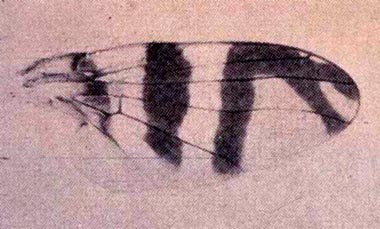|
|
||||||
 |
||||||
|
|
|
|
|
|
||
Western Cherry Fruit FlyDamageLarvae (maggots) feed in the flesh near the pit of cherries rendering them unmarketable.IdentificationAdult - Slightly smaller than house fly, black body with yellow markings near base of wings and white stripes across abdomen. Wings have black markings, which are used to identify this pest from related fruit flies.Larva - White, legless maggot-like with no distinct head; about 5-6 mm long when mature. Pupa - About 4-5 mm long, brownish, elongate-oval shape.
Life HistoryOverwinter as pupae in soil under trees. Adults are present from June through August, generally peaking close to harvest. Flies are weak fliers and will usually not travel farther than the first cherry tree they find. Five to 9 days after emerging, female flies lay eggs singly in cherries and larvae feed for 1-2 weeks before cutting exit holes and dropping to the ground to pupate. Only one generation is produced each year.MonitoringMonitor for presence of cherry fruit flies using commercially available sticky yellow traps (bait with ammonium carbonate to increase attractiveness). Hang the traps in early June at eye-level in exposed sunny parts of the trees. Use a minimum of 4 traps with an average of two traps per hectare in large solid blocks. Mixed plantings require more traps. Inspect traps daily until the first fly is caught, then at weekly intervals. Yellow sticky traps are not very efficient for detecting fruit flies, especially when numbers are low, such as in well-managed commercial blocks. Because outside unmanaged sources are a common threat to most growers, it is important to monitor borders nearest these sources. This will ensure early detection of flies entering the block and timely application of protective sprays to prevent establishment and spread.ControlCultural - Destroy infested cherries before the larvae emerge. Removal of all cherries at harvest will eliminate breeding sources and reduce fruit fly numbers for next season. Destroy any unmanaged cherry trees where possible.Chemical - The low efficiency of yellow sticky traps and zero tolerance for fruit flies in fruit requires protection of the fruit throughout the summer when fruit flies are active, regardless of trapping results. If using traps, apply a control product within 6 days of first fly capture and maintain control until harvest. In the absence of traps, begin protecting fruit about the time Lambert cherries begin to colour. Research shows female fruit flies will lay eggs in green fruit. This means application of sprays to the new later maturing varieties when the fruit may still be green. Products Recommended for Cherry Fruit Fly Control
Do not risk fruit infestations by exceeding the spray intervals. Re-apply the products if measurable rain occurs within 24-48 hours of application. Sevin XLR, Guthion 50WP, Sniper 50WP, Diazinon, Zolone Flo, Entrust 80 W and GF-120 sprays will only control adult fruit flies. Apply the first spray not later than 6 days after capture of the first fly followed by sprays at recommended intervals to maintain protection of fruit. Entrust and GF-120 are approved for use in organic cherry blocks. Both products contain spinosad. GF-120 requires a special sprayer which can be purchased or fabricated - do not use an air-blast sprayer. Because GF-120 does not control other insect pests, growers should monitor for the presence of other pests to determine need for alternative sprays. Carefully read the label instructions before applying GF-120. Entrust will also control leafroller and bud moth larvae present at the time of application. Admire 240F has some residual contact activity against adult flies (2-3 days) but will kill larvae hatching in the egg for 10 to12 days post treatment because it is absorbed into the fruit. Admire will also move into the branches and out to the growing tips where it will control any black cherry aphids present. Research shows that Admire increases mite populations without a significant decrease in predatory mite numbers. Therefore do not use Admire more than twice per season. Avoid use of any chemicals harmful to predatory mites in blocks treated with Admire to avoid mite flare-up. Monitor mites the following spring to assess the risk of mite problems. Cygon and Lagon will control fruit fly adults, eggs and young larvae within the fruit for about 3 weeks. Because this spray may not protect the fruit up to harvest, an additional application of Admire, Diazinon or Sevin may be required. Be aware of the preharvest intervals. For sour cherries, do not apply more than two sprays per season. Apply the second spray 14-21 days after the first. Apply post harvest sprays of Cygon or Lagon to prevent late-emerging fruit flies breeding in unharvested whole or split cherries. Field reports suggest that control products formulated as emulsifiable concentrates (EC) can cause severe leaf burn and possible drop in Lapin, Sam, Stella, and Sweetheart cherry varieties. June 2006
Return to Tree Fruit Pests and Diseases
|
|||||||||||||||||||||||||||||||||||||||||||||||||||||||||||||||||||
|
|
|||||||||||||||||||||||||||||||||||||||||||||||||||||||||||||||||||

